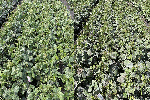The more Australian researchers learn about Russian wheat aphid (RWA), the more confident they are that the pest does not pose a major threat to winter cereal crops in this country if growers and advisers understand how to manage it effectively.
This is the message from GRDC pests manager Leigh Nelson, following the detection of RWA in wheat crops north of Esperance in Western Australia.
It is the first time the pest has been detected in WA, after being discovered in South Australia in 2016 and subsequently in Victoria, parts of New South Wales and Tasmania.
According to the Department of Primary Industries and Regional Development (DPIRD), which is conducting further surveillance, eradication in WA is unlikely due to the biology of the pest and its ability to spread via the wind and multiple other grass hosts.
Dr Nelson says scientists have been studying RWA under southern Australian conditions and within local farming systems since it was first detected in 2016.
“Through research investments by the GRDC, a biological and ecological profile of the pest is being built to provide Australian grain growers with scientifically robust management tactics for the future,” she said.
“These investments are being led by the research division of the South Australian Department of Primary Industries and Regions – the South Australian Research and Development Institute (SARDI), and cesar.”
Dr Nelson says monitoring and making threshold-based decisions remained key to effective long-term management of this aphid.
SARDI entomologist Maarten van Helden says treatment of RWA should only be considered if infestations are at potentially damaging levels.
Dr van Helden, who has helped to lead GRDC-invested RWA thresholds-related research, says thresholds based on Australian conditions will be available soon and show that RWA has less impact than reported in overseas conditions.
“Based on the overseas findings, a spray application is recommended when more than 20 per cent of all seedlings are infested with aphids up to growth stage 30 (early stem elongation) and more than 10 per cent of tillers are infested with aphids from growth stage 30,” he said.
Dr van Helden said symptoms of RWA – including striping and rolling of leaves, and sometimes purple discoloration – are always the first sign of presence of RWA and may stay visible even after aphids have disappeared.
“It is important to check for symptoms and suspicious plants need to be checked for the presence of the tiny green aphids inside the youngest leaves,” he said.
A RWA resource portal which includes updates on current research efforts and the latest RWA management advice, hosted by cesar, is available. Visit GRDC's website for RWA information.
GRDC-invested research is also investigating how RWA survives over summer. This knowledge is considered pivotal in determining the risk of infestation for winter sown cereals and potential damage ahead of each new cropping season, as well as aiding RWA management planning and development of cultural controls.
Recent research is discussed in a GRDC podcast, ‘Just how many Russian wheat aphids is too many’, and another GRDC video, ‘RWA green bridge surveillance’.
Refer to the Australian Pesticides and Veterinary Medicines Authority products and permits databases for chemical control options available for RWA in grains crops.
Look for RWA plant damage symptoms on barley and wheat, including white and purple longitudinal streaks on leaves, and curled, rolled or hollow tube leaves.
WA growers and agronomists are encouraged to report aphids and suspected RWA damage to DPIRD’s Pest and Disease Information Service on 08 9368 3080, padis@dpird.wa.gov.au or the MyPestGuideTM Reporter app.

























































